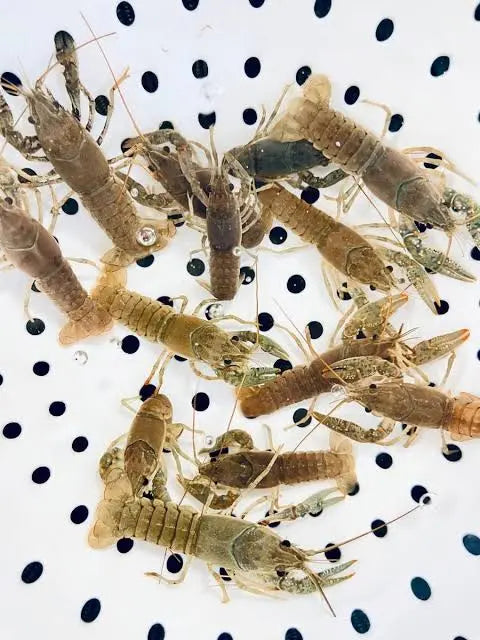
Yabbie – Blue Claw Yabby / Crayfish 4cm
Guarantee Safe Checkout
Note : Yabby can have 2 claws or 1 claw as they can fight with each other and lose the claw . We sell them happy and healthy , however , it can be 1 claw sometime . Yabby claw will grow back .
These are livestock that live in group hence its best to get them
as the quantity we suggest to make sure they are happy and thrive together ❤
Yabbies (Cherax destructor) Care Guide and Tank Mates
Overview
• Common Name: Yabby
• Scientific Name: Cherax destructor
• Origin: Australia (freshwater rivers, lakes, and ponds)
• Lifespan: 5–7 years with proper care
• Size: Up to 30 cm (12 inches), though commonly around 15–20 cm (6–8 inches) in aquariums
Tank Requirements
1. Tank Size:
• Minimum 20 gallons for a single yabby; 40+ gallons for multiple individuals.
• Larger tanks reduce aggression and provide more territory.
2. Water Parameters:
• Temperature: 18–25°C (64–77°F)
• pH: 6.5–8.0
• Hardness: 100–250 ppm (moderately hard to hard water)
• Filtration: A strong filter is needed to handle waste, but avoid strong currents. Sponge filters work well.
• Water Changes: Regular 20–30% water changes to maintain quality.
3. Substrate and Decorations:
• Substrate: Sand or fine gravel, as yabbies like to dig and burrow.
• Hiding Spots: Essential to reduce stress; use PVC pipes, caves, rocks, or driftwood.
• Plants: Live plants are not recommended as yabbies tend to uproot and eat them; opt for hardy plants like Java fern attached to rocks.
• Lid: A secure lid is necessary since yabbies are known to climb and escape.
Diet
Yabbies are omnivorous scavengers and will eat a variety of foods, including:
• Protein Sources: Shrimp pellets, sinking fish food, cooked shrimp, and fish.
• Vegetables: Zucchini, carrots, spinach, and peas.
• Occasional Treats: Algae wafers, live or frozen bloodworms.
• Feeding Frequency: Feed every 1–2 days, ensuring they get enough but do not overfeed to prevent water quality issues.
Behavior and Temperament
• Temperament: Territorial and sometimes aggressive, especially towards other bottom dwellers.
• Activity: Nocturnal but may become active during the day when comfortable.
• Molting: Yabbies molt as they grow; they will hide during molting and should not be disturbed. Provide calcium-rich foods to support shell development.
• Aggression: Can become territorial, especially in confined spaces, so provide enough hiding spots to reduce stress.
Tank Mates
Yabbies can be aggressive, so tank mates should be chosen carefully.
• Suitable Tank Mates:
• Fast-moving fish (e.g., danios, larger tetras, and rainbowfish)
• Large, non-aggressive fish that stay in the upper levels (e.g., silver dollars)
• Snails (though yabbies may eat them over time)
• Other yabbies (only in large tanks with ample hiding spots)
• Tank Mates to Avoid:
• Slow-moving or bottom-dwelling fish (e.g., plecos, corydoras)
• Small fish that can be caught (e.g., guppies, neon tetras)
• Delicate fish that may be stressed by the yabby’s presence
• Shrimp and other crustaceans (as they may be eaten)
Common Health Issues
• Shell Damage: Caused by aggressive encounters; ensure enough calcium for shell repair.
• Parasites and Fungal Infections: Maintain good water quality and avoid introducing sick fish.
• Stress: Caused by inadequate hiding spaces or poor water quality, leading to reduced molting success.
Breeding
• Yabbies can breed in captivity if provided with proper conditions.
• Females carry eggs under their tails (berried) for several weeks until they hatch.
• To breed successfully, separate breeding pairs from other tank inhabitants to avoid predation.
Selling size : 4cm
What to Expect from Us
All Aquatic plants and animals come with a 100% live arrival guarantee!!

| Quantity |
1 Yabby 4cm unsexed, 4 Yabbies |
|---|
